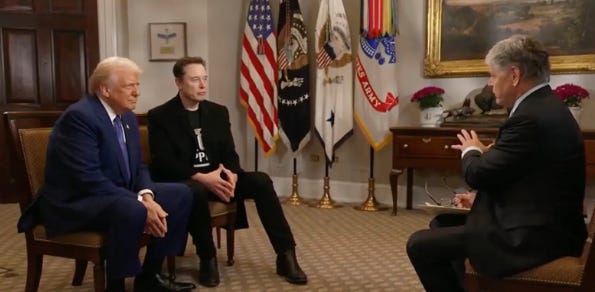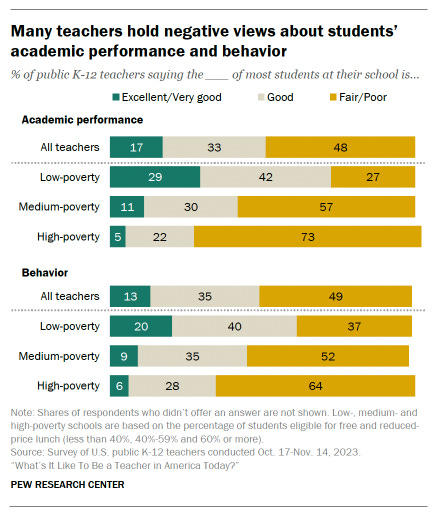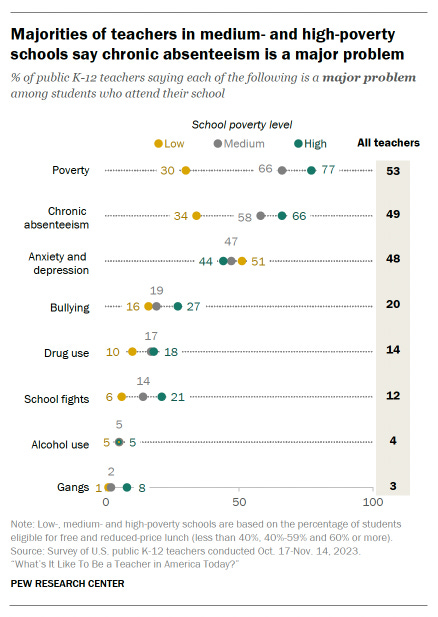America Must Adopt Education Policy from Abroad
Donald Trump suggests US education should emulate the success of Finland, Sweden, Denmark, Norway, and even China. He's right, but he would never.
For the most part, Trump on Sean Hannity a couple of weeks ago was the standard circlejerk it usually is: a softball Q&A with no real pushback or confrontation. Hannity has always been less of a commentator or analyst around Trump and more of an overzealous fan ready to kneel at the feet of his godking. It certainly serves Trump best these days because while it was glaringly apparent on the campaign trail, his senility in this second term is impossible to ignore. I’m not even talking about what Trump coined as “the weave,” where his inability to string thoughts together was branded as a galaxy-brained rhetorical strategy. I’m referring to his growing inability to maintain ideological coherence. This may have been why he took a backseat to Elon Musk through most of the interview.
Musk’s presence here is important for a plethora of reasons, not least of which is how his wealth juxtaposes Trump’s suggestions about US education. Towards the latter half of the interview, Hannity gets around to asking about the Department of Education and why we can do away with it. Trump doesn’t get too deep into it, but he does manage to take the lead on this question. In the midst of dropping some auspicious mentions of school choice and giving education back to the states, he makes note of how US education is lagging behind other countries. Specifically, he mentions Sweden, Norway, Finland, Denmark, and even China as benchmarks for what he’d like US states to become. This is not the first time he’s brought this up either. He talked about it during the campaign, and just a few weeks before going on Hannity, he put out the exact same line1 to a room full of reporters.

For context, the rankings Trump is talking about here2 are not as cut and dry as he’d like them to be. He doesn’t even get the numbers right. The US is not ranked last in anything, and he’s placing the US as 40th out of 40, which also isn’t correct because the rankings he’s talking about have 81 countries. Even if—which he probably is—Trump is only referring to comparable OECD nations, that’s still only 37 countries. Not that fact-checking this kind of stuff matters anymore, but it’s important to see the real picture because knowledge is power, ya know?
What he’s more than likely referencing are PISA (Program for International Student Assessment) and TIMMS (Trends in International Mathematics and Science Study) rankings. Let’s look at some quick numbers from the National Center for Education Statistics (coincidentally a research entity that has been hit by DOGE cuts) that showcase the gap in American student outcomes compared to other countries:
The US ranks 34th on the NCES mathematics literacy scale for 15-year-old students behind countries like Denmark, Sweden, Norway, and China.
The US ranks 9th on the NCES reading literacy scale behind countries like China but ahead of the Scandinavian countries.
The US ranks 16th on the NCES science literacy scale behind countries like China, but just marginally ahead of the Scandinavian countries.
As we see, the US is not particularly excellent at anything and exists on a spectrum of good to pretty bad. If Republicans are serious about improving academic outcomes, then the United States should unequivocally look to other countries and adopt their most successful initiatives, both inside and outside the classroom. The only problem is that nothing about Republican policy is going to get us there. The gall to go so far as to put those countries—countries that typically operate within a socially democratic framework—on a pedestal with the world’s richest man barely a foot to your left is astounding. This is one of the most infuriating things about the entire Republican apparatus. They will see a problem and do the opposite of what the solution is.
To frame US inadequacy in a way that calls for school choice and the removal of federal oversight as the solution is disingenuous in the most classically Republican way. The ways in which US education differs from other high-performance nations are vast and beyond the scope of a single article, but it’s worth looking at some key basics. First and foremost, the countries Trump has mentioned prioritize their teachers in a way that is totally absent in the United States.
Evaluating Teacher Value
If we are to work on improving student outcomes, then we must work to improve the environments of the frontline educators whose job is seen as the most important factor in accomplishing that. Arguably the largest distinction that the US holds in comparison to other wealthy nations is how it values teaching as a profession. On its face, there are the obvious differences: American teachers are paid significantly less to work longer hours for fewer benefits. All of this plays a role in America’s teacher shortage crisis, compounding over decades to increasingly devalue teaching as a professional field. As test scores decrease and student outcomes worsen, the perception of public education—on the right in particular—has put teachers front and center as enemy number one.
There is a level of professional respect applied to teachers in other countries that simply does not exist in America. Schools here operate more as factories to churn out laborers than they do as institutions creating individual thinkers. That has, in effect, degraded education as a specialized profession and turned teaching into a position that can be filled by anybody. Take the teacher shortage, for example. In Texas, many school districts have removed certification requirements in order to be hired. States like Oklahoma, Arizona, and Florida have dropped the requirement of needing a bachelor’s degree. Would you trust an engineer with no credentials to design a bridge? It’s subtle, but American policymakers have made it clear that they value the worth of teachers so little, they would rather backfill the position with unqualified individuals than provide teachers with the necessary resources to succeed.
High-performance countries like Finland and China get all of their teachers anywhere from the top half, to as high as the top 5%, of high school graduates3. Finland in particular set the standard among Nordic countries in the late 70s by implementing a rigorous, 5-year, research-based master’s course for teacher education. In addition to stricter education requirements, high-performance countries have made concerted efforts to improve teacher recruitment by making teaching as attractive as possible. Teachers are paid fairly and in proportion to other professions that require the same amount of education4 and, as a result, teacher status is elevated.
The execution of instruction itself is also different in high-performance countries, as, much like other specialized fields, teachers are afforded a high degree of autonomy in how they operate within their classrooms. Teacher autonomy in America is minimal, and they are beholden to a methodology that leaves little room for experimentation. By emphasizing the rigid process of teaching students to merely pass standardized tests, teachers manage to have little say in the curriculum while still maintaining a high degree of accountability.
In Sweden, for instance, teachers see themselves as “…very autonomous, in particular in relation to choices of content and method.”5 When you put the power of decision-making into the hands of the educators themselves, you give them the flexibility to work in accordance with the needs of the students. Increasing teacher autonomy is a heavily studied, core aspect of a teacher’s job satisfaction6.
Unfortunately, Republicans view teacher autonomy as the primary driver behind their perceived Marxist indoctrination in public schools. There’s a ton of irony—some might call it hypocrisy—in the policy of the freedom party that is designed to restrict the abilities of teachers to do their jobs. The best example is Florida’s 2022 legislation that enacted a myriad of requirements in how teachers should talk about slavery and American history, not to mention the nationwide book banning spree over the last few years. Still, it is not just teacher satisfaction alone that makes a difference. The systemic and structural rot at the core of the United States has adversely affected schools and the communities in which they serve.
Looking Inward and Outward
It would help to listen to teachers as well. In treating them as consummate professionals and experts on the subject of childhood education, we should prioritize their concerns about student performance. There are a few correlating concerns put forth by teachers that reflect America’s inadequacies in ways that only reality could.
Nearly half of all teachers hold negative views towards both their school’s academic performance and the behavior of their students. Most notably, teachers in high-poverty schools hold negative views at 73% and 64%, respectively. This leads us to our next concern.
Wealth inequality in America is at levels approaching pre-revolutionary France7, and teachers don’t have to be card-carrying communists to notice it in their own way. Among all teachers, poverty is seen as the single biggest issue facing their students today. Poverty does not just mean you are cash poor. It serves as a catalyst for every issue affecting a child’s ability to get a good education. A child living in poverty may find it more difficult to get to school each day. They may be less likely to get the help they need to improve their grades, or they may have to take time out of schoolwork—or the school day—to watch over younger siblings because their parents have to work. The list goes on and on as to how poverty affects every other aspect of a child’s life, including their education. As the saying goes, it’s expensive to be poor.
At a close second is chronic absenteeism, which has skyrocketed in a post-pandemic world with no sign of return to pre-pandemic levels. Absenteeism at this scale is not just a spontaneous choice to miss random days of school. It is a reflection of the poor socioeconomic conditions afflicting communities across the country. Unsurprisingly, most of the root causes of absenteeism were problems exacerbated by the pandemic. Food and housing insecurity, social anxiety, lack of reliable childcare, and growing distrust in science and institutions have all fractured the cohesion between schools and the communities in which they serve. There are innate, structural deficiencies in how America cares for its people. Both Republicans and Democrats alike point to any number of reasons for what they believe is the cause of declining test scores across the country, but rarely do they look beyond the classroom.
As for the countries Trump would like the US to emulate, we can start with the Gini Index we used to compare the US’ wealth inequality to pre-revolution France. Right now the US sits at a coefficient of 41.3. Comparatively, the other countries are as follows:
Sweden - 29.8
Norway - 27.7
Denmark - 28.3
Finland - 27.7
China - 35.7
We are looking at coefficients significantly lower than where the US sits. Further, the rate of childhood poverty in America is drastically higher than in other OECD nations. While not listed in the graph linked above, Sweden, Finland, and Denmark have much lower levels of childhood poverty than the US. Childhood poverty is the single biggest contributing factor to a decrease in future earnings, so our immediate takeaway here is that children in the countries Trump so adamantly wants to mimic are more commonly positioned to succeed from the earliest possible age. If a student’s material conditions are better, we can cut right through the central causes of absenteeism as well.
Harkening back to our discussion about teacher autonomy for a second, when we see that structure and organization within schools, along with positive relationships between students and teachers, are the driving forces behind keeping students in school8, we can understand the scope of how important it is to let educators apply their expertise in their own ways. Teaching for the students instead of the test is a fundamental part of creating a more enjoyable and welcoming schooling experience.
We Live In A Society
Lastly, it must be reiterated that on a functional level, every country Trump mentioned operates within the framework of a socialist to socially democratic welfare state. These countries have some combination of universal healthcare, universal childcare, free higher education, and a myriad of social safety nets that provide for their people in a way the US doesn’t even come close to. The tax-to-GDP ratio in Denmark, Norway, and Sweden is almost double what it is in the US. This is how these countries are able to supply communities and schools with the necessary resources to succeed, and this is why having Elon Musk sit beside Trump during this interview is so irritating. That is an unacceptable reality to live in. Wealth concentration in America is completely out of control, and reforming American education is not going to work, let alone happen at all, unless that wealth is adequately redistributed.
If there is anything to take away from what I’m saying in all this, it is this: all of these high-performance countries see schools as a public good that serves as a core pillar for a thriving society. What Republicans want to do to public education in America could not be more antithetical to what creates successful education systems abroad. This is not to say other countries are utopian societies liberated from the shackles of oppression, free from any and all shortcomings. But my god, it is not rocket science to see what’s working elsewhere and integrate that blueprint here in America. It’s insulting for Trump or any politician for that matter to acknowledge the shortcomings of American education, but look to privatization as the solution. The time is now to demand more of our leaders and tax the wealthy, support schools, support teachers, and support the communities they reside in.
A little after the 21:20 mark
Same page as footnote 2, next paragraph
First paragraph under the header “Literature review”
The Gini index measures the extent to which the distribution of income or consumption expenditure among individuals or households within an economy deviates from a perfectly equal distribution. The United States currently sits at a 41.3. Pre-revolutionary France got as high as 55.9. Whether you think 14.6 points is a huge difference or not, don’t you think that’s still maybe a little too close for comfort?
The chart I’m referring to can be found underneath the “Theoretical Framework” heading




Great research and analysis. We can’t expect American students to excel unless they respect education and they will never respect education unless we respect teachers and pay them accordingly.